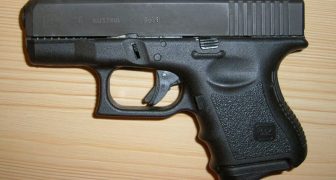This a guest post
Let’s be real – you need the right AR Optic for your AR-15. Good thing we’re sharing how to pick the scope that hits the mark here.
The AR-15 often gets a bad name. Most people don’t realize that the AR does not stand for assault rifle, but instead for Armalite rifle.
Contrary to popular belief, they’re a weapon that’s almost never used in the commission of a crime.
In fact, the “assault style” weapons only accounted for 2 percent of gun crimes nationwide before the 1994 assault weapon ban. That means AR-15s make up an even smaller percentage of gun crime.The misinformation surrounding the firearm is worrying in a country that guarantees basic gun rights.
The true story behind the AR-15 follows a gun praised by hunters and target shooters alike for its low recoil, high capacity magazines, and extreme accuracy.
A new AR-15 comes with everything needed to start shooting right away (except bullets). But to fully realize this gun’s potential, you’ll need to make a few improvements.
The most important part of shooting an AR-15 is ensuring your accuracy is spot on. Inaccuracy is dangerous and also defeats the purpose of owning one of the most accurate guns on the market.
The best way to ensure stunning accuracy is a quality optic sight.Optic sights come in all shapes and size. They’re so many varieties that AR-15 owners need to break down what they expect from their weapon before making a purchase.
Let’s take a look at the available scope options for the AR-15, and discuss which are best suited for different circumstances.
How Powerful is Too Powerful?
The first step in determining the correct optic for your AR-15 is deciding your weapon’s main use. An AR-15 for home defense will need a different scope than an AR-15 for distance target shooting.
The main variance found in scopes across different applications is magnification. Unsurprisingly, this makes magnification the number one mistake people make when choosing optics.
Everyone wants to shoot a peanut off a needle at 400 yards, and if that’s what you’re using the gun for, great! However, few people will ever need a scope with that kind of magnification.Fixed Optics
People using their weapon for home defense should invest in a red dot scope. These scopes normally offer zero magnification. Hunters who shoot moving deer should also consider a red dot.
The reasoning behind non-magnified optics for moving targets and targets at range comes from two factors; natural wobble, and width and height visible through your scope.
Natural wobble refers to the body’s natural shaking when holding a pose. On a bench, the wobble doesn’t come into play, but firing while standing will cause some shake. Magnification only makes the shaking worse.
Width and height refer to how much you’re able to see through your scope. The measurements are collectively called as field of view. The more magnification, the less field of view you have.
With these two factors in mind, it’s easy to see why a moving target would become an issue for optics with a high magnification.Variable Optics
However, for situations where the target is stationary, variable magnification (different levels of magnification) becomes useful.
Hunters who hunt from tree stands and long distance target shooters both should look at scopes with a variable magnification. The ability to zoom in allows shooters in either situation to increase accuracy based on fluctuating distances.
Target shooters can eliminate wobble with a bench, and tree stand hunters can use the tree as a rest. Field of view becomes a non-issue when focusing on a stationary target at long range.
Pick Your Reticle
After you’ve identified your weapon’s application and the needed amount of magnification, it’s time to choose a reticle.
The reticle is what a shooter rests on his or her target. The most common kind being crosshairs.Choosing the proper reticle for your AR-15 depends largely on the magnification of your optics. Most optics come with a variety of choices in a reticle, but that doesn’t mean every option is a good choice.
Distance shooters should choose a reticle that compliments their high powered scope. Sure, you can buy high powered scopes with a red dot, but you shouldn’t. Pick a reticle with holdover marks. These marks run along the crosshairs and indicate things like bullet drop and wind speed.
Home defense users and others utilizing low magnification optics should consider a red dot reticle. You’ll need to understand something called minutes of angle to discern why.
Minute of angle comes from a circle’s 360 degrees divided into 60-minute sections. The 60-minute sections are further broken down into individual minutes, giving us minutes of angle. Each minute of angle equates to about 1 inch at 100 yards.
At 100 yards, an AR-15 shoots at around 2 minutes of angle, meaning each shot will impact at an inch or less away from the others.Red dot reticles in low magnification scopes should cover around 2 minutes of angle in close quarters. This means any shots aimed correctly should fall behind the dot and into the target.
Like with magnification, reticles come in all shapes and sizes. Comparing the advantages and disadvantages of each reticle typed based on magnification would take days.
Deciding On The Little Things
This is where buyers finally can throw procedure to the wind and buy what they desire.
Optics vary so much that after choosing the correct reticle and magnification configuration there are still many choices left.
Buyers should consider weight, color, mounting configuration, and more before they purchase optics for their AR-15.
Users seem to find eye relief one of the especially important variable choices.
The eye relief of a scope is the distance your eye must be from the ocular lens to bring the scope’s image in focus. Some people find a shorter eye relief comfortable, while others prefer longer relief.
The best part about the little things is that all of these choices are largely up to the user and will have minimal effect on how your firearm actually shoots.
Picking the correct optics for your AR-15 is a balancing act between conventional needs and user customization.
Delve into the world of AR optics and find yourself something to be proud of.



Speak Your Mind